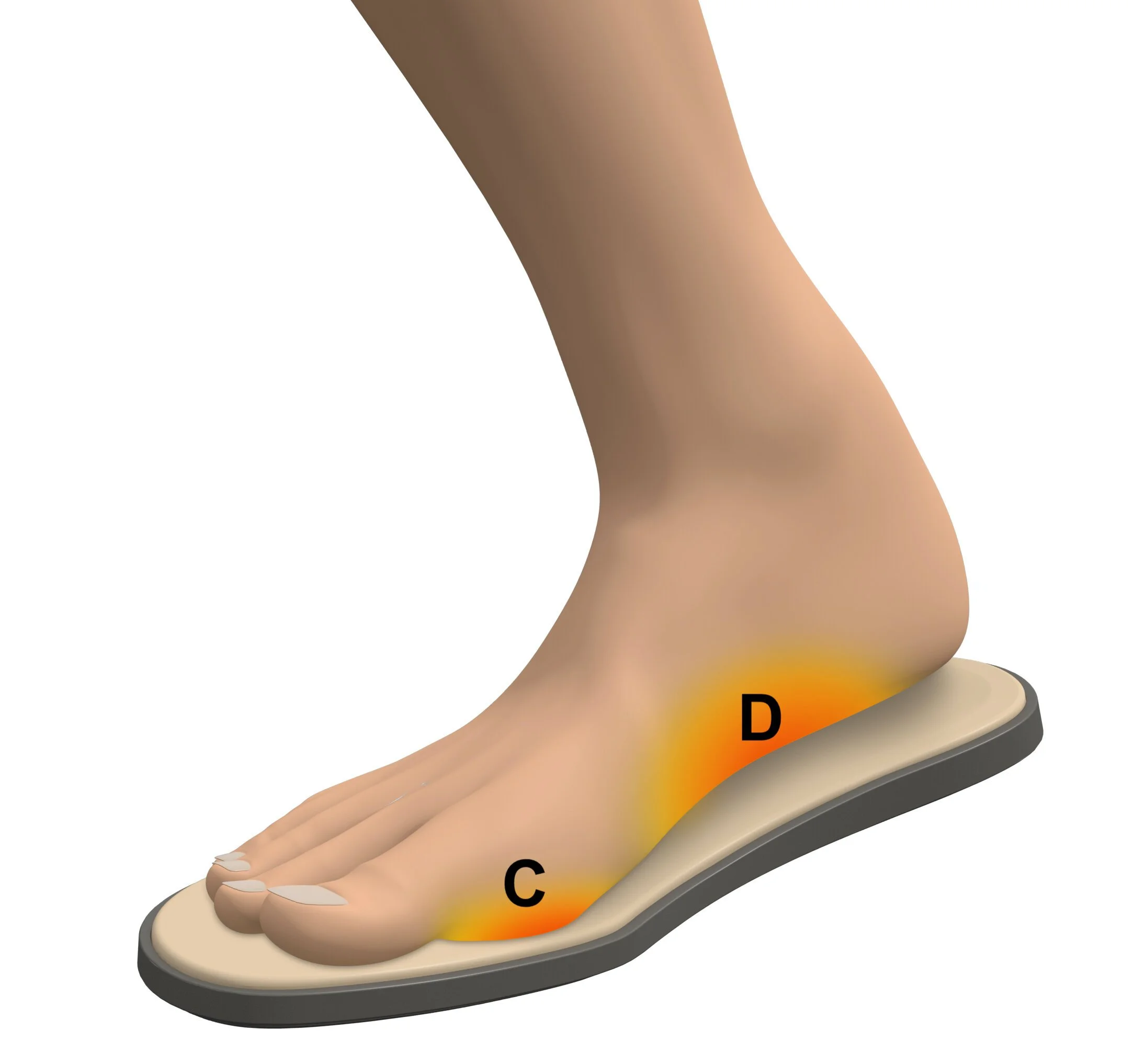Insolia Flex® And Insolia FlexPlus®
Our understanding of dynamic foot motion, informed by our early work with the TekScan F-Scan foot pressure measurement system, enabled us to develop Insolia Flex®, whose utility patent was issued in 2012. This innovation was further refined in Insolia FlexPlus®, whose utility patent was issued in 2020.
These patented Insolia Technologies are proven to enhance natural foot flexing when walking or running, which encourages the foot to push off efficiently.
Insolia Flex has been shown to increase both perceived forefoot comfort and biomechanical efficiency with statistical significance.
Insolia Flex Plus adds biomechanically correct Metatarsal Support.
A key aspect of Flex and Flex Plus is knowing where to place it. We did this analysis using data from the report, Anthropometry of the Foot and Lower Leg of U.S. Army Soldiers: Fort Jackson, South Carolina – 1985 by Kenneth R. Parham, Claire C. Gordon, and Carolyn K. Bensel (1994).
Insolia Natural Dynamic Arch®
Triggered by proper movement at the toe joints, Insolia Flex and Insolia FlexPlus allow feet to dynamically adjust the shape and height of the Arch, depending on need.
The traditional “Arch Support” is designed for a static load, i.e., supporting the Arch when standing.
But we move, and when we move, the foot’s Arch stores and releases energy during walking or running. To do this, the Arch must be free to dynamically change shape and not be constrained by fixed arch support.
With Insolia Flex/Flex Plus the pivot point A at the big toe joint properly drops and rotates relative to the rest of the metatarsals. This allows the Arch B to to rise to its ideal position for each phase of the gait cycle. The result is the Insolia Natural Dynamic Arch®.
The relative drop and rotation of the big toe joint enables the foot to move freely for an effective push off. This allows complete lifting of the heel which delivers a full and efficient stride.
Without Insolia Flex/Flex Plus the ball has not fully flexed C resulting in a much less efficient push off. The Arch D must then strain to lift the body weight, resulting in leg, arm and lower back muscles having to make up for the lost energy. This compensation leads to a less efficient, uncomfortable walking experience.
Physiological Analysis
The Wales Centre for Podiatric Studies and the Centre for Biomedical Sciences, both at the University of Wales Institute in Cardiff in the U.K., undertook a study on the "Influence of Insolia® Flex on Energy Efficiency during Walking in Male and Females."
While the results were not as dramatic as the high-heel study, we learned a tremendous amount from this independent study.
The first slide shows how the test was conducted and, more importantly, shows the difference in the footwear used by the men and women. Unfortunately, a number of the women developed blisters during the test, and not surprisingly, the results were not as positive as the men’s. As with the high heel test, breathing gases were tracked, as were heart rates and the number of steps taken.
Once they had finished each trial, they were asked to rate various aspects of the comfort of the shoes by pointing to a 15 cm scale marked from 0 to 15, where 0 was "not comfortable at all,” and 15 was "the most comfortable condition imaginable.”
This data was then analyzed, and the statistically significant results are shown below and in the summary charts that follow.
Insolia Flex: Statistically Significant Results (p <0.05)
The Insolia Flex Effect on the 15 Men Tested:
Reduced the average VO2/kg by 10.3%
Reduced the average heart rate by 9.1%
Reduced the average number of steps to cover the distance by 3.6%
Improved the average Forefoot Comfort Scale measurement by 39.1%
Improved the average Overall Comfort Scale measurement by 39.5%
The Insolia Flex Effect on the 15 Women Tested: (despite significant fit & comfort issues with test shoes)
Reduced the average VO2/kg by 8.7%
Reduced the average heart rate by 1.8%
Improved the average Forefoot Comfort Scale measurement by 18.1%
Click on any of the images below to enlarge them. You can move from slide to slide with the arrow keys or by swiping on your tablet. Hit ESC or the "X" in the upper right to return to this page.
3D Motion Capture (MoCap) Analysis of Insolia Flex
Shortly after we completed the Insolia Heels Motion capture session, we had the first consumer product prototypes of an insole incorporating Insolia Flex. We decided to see what we could learn from a motion capture session done the same way.
The video below was of one woman walking in the same pair of running shoes. Once with the standard insoles and again with the Insolia Flex insoles. The review of the motion capture analysis explained the differences we saw with Insolia Flex in the Gait Lab testing. The reduction in upper body motion with Insolia Flex explains the 10% reduction in VO2/kg, and the increased flexing of the push-off foot that results in increased stride length is clearly visible.
Also worth noting is the dramatic reduction in motion of the head when the subject is walking with Insolia Flex Insoles.
What happens at your feet propagates up the entire body.
Insolia Cradle®
This Patented Insolia Technology was developed based on the observation that while heel cups are smooth and symmetric, the calcaneus (heel bone) is in fact, asymmetric. When we tested this concept with 3D printed prototypes, we were surprised at the difference that subtle adjustments made in measured weight shift and perceived comfort.
Patented Insolia Technology provides the only anatomically correct calcaneus (heel bone) matching heel cup.
Matches the irregular shape of the heel-bottom surface. Provides an improved platform for balance, stability, and function.
An asymmetric profile extended along the medial side reduces the strain on the plantar fascia.
Results in improved standing and moving comfort.
Summary
The above describes how HBN Shoe took the problem solving and product development methods developed in our work with high heeled shoes and applied them to walking shoes or “flats.”
Our history and the development of our high-heel technology is told in the section History & High Heels.
Our Intellectual Property strategy is discussed in the IP Summary section.








